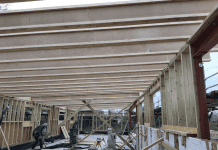William Poole-Wilson, founder and managing director of WILL+Partners, explains the role of architectural apprenticeships in overcoming the diversity crisis
There is no denying that the architecture industry is in the midst of a longstanding, entrenched diversity conundrum.
Indeed, data which has been collected since 2012 by the UK government’s Architects Registration Board, better known as Arb, makes for concerning reading.
In its 2019 Annual Report, Arb revealed that just 1% of architects identify themselves as black, with 71% of architects registered being male. Architecture is still a sector dominated by white males, with 73% of all registered architects in the UK being over the age of 36.
However, there are some promising trends emerging in the younger age cohorts when it comes to gender equality – as of the end of 2019, 50% of registered architects under the age of 30 were female.
On the flipside, given the overall proportion of female architects standing at just 29%, this does suggest substantial numbers of women are dropping out of the industry after becoming mothers, which points to a cultural problem within practices around supporting families.
As well as ethical and fairness issues in regard to access to the profession, the diversity problem compounds what is already a sector struggling to plug its skills gap.
In late 2019, architects were officially added to the UK Home Office’s Shortage Occupation List. Then in October 2021, RIBA published its annual Future Trends survey which found that 18 percent of practices were struggling to recruit, with more than four in 10 medium and larger firms suffering from staff shortages.
Other factors such as Brexit and the Covid-19 pandemic have assumed their fair share of the blame, but the diversity and inclusivity problem is difficult to ignore. There is simply too much talent out there that we are not spotting and bringing through the system.
And that very system is an onerous one to navigate. It takes seven years to become an architect – at least four or five of those years will be spent at university with course fees of at least £9,000 per annum. Once the costs of accommodation, materials, travel, software and even printing (2D and 3D) are added into the mix, the debt pile will no doubt put a lot of people off, especially those from poorer backgrounds.
The current regime is also expensive for practices. For smaller firms such as ours, sourcing real-life projects to facilitate the completion of RIBA Part 3 consumes a significant amount of resources.
Attracting the best through apprenticeships
Serious discussions around the diversity problem are at least beginning to pick up. For example, diversity and access is an issue that Arb acknowledges and highlights strongly in its 2020 Annual Report, its Chief Executive High Simpson pledging to “facilitate an open conversation about the educational journey of prospective architects”, adding that “this conversation needs to explore lack of access and diversity”.
Apprenticeships, I believe, will have an influential role to play here. While they may be seen as a cheap option or alternative to a traditional architecture education, apprenticeships are the first step to transforming the relationship between employers and educators and opening up access to the sector.
We can leverage these programmes to attract the best talent into the sector, offering opportunities to a pool of people far greater than one restricted by who can afford university fees.
Indeed, apprenticeships carry numerous benefits – from supporting students with cost burdens to establishing direct paths to employment and helping practices assume greater control over their talent development.
Practices like ours contain the knowledge and experience to teach budding architects the skills they need, and we curate environments that can ignite a passion that a lecture theatre or classroom cannot replicate.
We’re trying to extract the best out of apprenticeships through the WILL Academy.
Sitting next to and feeding into our WILL+Partners Research & Development unit, the Academy is an internal practice-wide research initiative for continuous learning both for internal staff and those outside of our organisation.
It provides outreach support to university graduate and post-graduate students through mentorship-based partnerships with universities. Critically, this presents work experience opportunities and internships that bridge the gap between industry and academia.
One of our apprentices, Ayo Ambali, is a shining success story. He joined us in May 2021 after winning a Stephen Lawrence Charitable Trust Scholarship prize – this after facing financial struggles associated with spiralling education costs.
Ayo has tremendous potential to make his mark on the architecture stage. An observant individual by nature and from a working-class background, the Academy is helping him to find his voice and believe in his talent – I am certain he will go on to achieve great things.
The road ahead
I am not suggesting that apprentices, especially in their current form, are a silver bullet answer to the profession’s inclusivity problem. Indeed, there are several more systemic obstacles that cannot be overcome by apprenticeships alone.
Practices still need RIBA-certified architects in order to operate, and we alone cannot deliver these qualifications. Fortunately, WILL+PARTNERS fosters very productive relationships with educational institutions, but there is a wider disconnect between educators and practices that needs to be addressed.
Likewise, the idea that qualifying as an architecture requires a one size fits all approach must be dispelled – some creative thinking is needed to engineer pathways that can be followed by people with varying circumstances and who learn differently.
There is also the million-dollar question of how to identify those that may be interested in taking up an architecture-based career. We need to establish means of finding the best talent in a way that is inclusive and grants equal opportunity to people from all backgrounds.
Awareness is critical here. Take the example of Ayo. One of the most striking features of his story is that he had little or no idea about the architecture discipline and the impact it has on our lives and surroundings during his school years – it was only when his family pointed to the profession because of his passion for drawing and maths that he decided to pursue this career path.
Had he been aware of the transformative nature of architecture at school, that decision would have been far clearer cut – in truth, the fact he is with us is down to chance.
Reaching more younger people will be key to addressing our discipline’s skills and diversity gap.
This can be achieved through schools and organisations such as the Stephen Lawrence Charitable Trust, now known as Blueprint for All, which provided an important leg up for Ayo by holding specialist workshops. An important part of this, from Ayo’s perspective, was being in a room with fellow ethnic minorities, people who held similar passions and determinations to pursue a career.
As the managing director of a practice, I want to leverage my own knowledge and experience and inspire others to advance and realise their ambitions. Practices can play a greater role in making architecture more accessible, and apprenticeships will be a significant part of that moving forwards.
William Poole-Wilson

Founder and Managing Director
Twitter: @Will_Partners
LinkedIn: WILL+Partners
Instagram: willandpartners

















